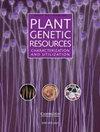生长习性对马兰产量及其组成性状的影响Verdc。)
IF 0.7
4区 生物学
Q3 PLANT SCIENCES
Plant Genetic Resources: Characterization and Utilization
Pub Date : 2023-08-29
DOI:10.1017/s1479262123000643
引用次数: 0
摘要
与其他谷类豆科植物一样,马豆的生长习性是驯化驱动的适应性状之一。马革兰表现出确定的和不确定的生长习性类型。确定的基因型具有不重叠的营养和生殖阶段,结合紧凑的生长习惯,使农民能够在间作和复作制度中生产马革兰,这是可持续农业生产的一种常见做法。此外,同步开花、荚果发育和成熟的确定基因型使机械收获成为可能。实证研究表明,与确定基因型相比,不确定基因型具有更大的粮食产量潜力。然而,我们假设,在等基因遗传背景下,不确定基因型和确定基因型的粮食产量潜力没有差异。为了验证这一假设,我们比较了8对近等基因(NI)不确定基因型和确定基因型在一个地点的两个雨季和另一个地点的一个雨季的粮食产量潜力。8对NI确定型和不确定型基因型在三种测试环境中均有显著差异。只有在少数遗传背景下,不确定基因型的豆荚(可收获)和谷物(可销售)产量才比确定基因型的豆荚(可收获)和谷物(可销售)产量高。因此,这些结果支持了我们的假设,即确定基因型与不确定基因型相当,如果不比后者更好的话。本文章由计算机程序翻译,如有差异,请以英文原文为准。
Effect of growth habit on grain yield and its component traits in horse gram [Macrotyloma uniflorum (Lam.) Verdc.]
In common with other grain legumes, the growth habit in horse gram is one of the domestication-driven adaptive traits. Horse gram exhibits determinate and indeterminate types of growth habits. Determinate genotypes have non-overlapping vegetative and reproductive phases combined with a compact growth habit which enables farmers to produce horse gram in intercropping and multiple cropping systems, a common practice for sustainable agriculture production. Also, synchronous flowering, and pod development and maturity of determinate genotypes enable mechanical harvesting. Empirical studies have indicated a greater grain yield potential of indeterminate compared to determinate genotypes. However, we hypothesize that indeterminate and determinate genotypes do not differ for their grain yield potential if they are in isogenic genetic backgrounds. To test this hypothesis, we compared eight pairs of near isogenic (NI) indeterminate and determinate genotypes for their grain yield potential during two rainy seasons in one location and one rainy season in another location. The eight pairs of NI determinate and indeterminate genotypes differed significantly in each of the three test environments. Indeterminate genotypes produced a greater pod (harvestable) and grain (marketable) yields than their determinate counterparts only in a few genetic backgrounds. These results thus support our hypothesis that determinate genotypes are comparable to indeterminate ones, if not better than the latter.
求助全文
通过发布文献求助,成功后即可免费获取论文全文。
去求助
来源期刊

Plant Genetic Resources: Characterization and Utilization
Agricultural and Biological Sciences-Agronomy and Crop Science
CiteScore
2.80
自引率
0.00%
发文量
29
审稿时长
>12 weeks
期刊介绍:
Plant Genetic Resources is an international journal which provides a forum for describing the application of novel genomic technologies, as well as their integration with established techniques, towards the understanding of the genetic variation captured in both in situ and ex situ collections of crop and non-crop plants; and for the airing of wider issues relevant to plant germplasm conservation and utilisation. We particularly welcome multi-disciplinary approaches that incorporate both a technical and a socio-economic focus. Technical aspects can cover developments in technologies of potential or demonstrated relevance to the analysis of variation and diversity at the phenotypic and genotypic levels.
 求助内容:
求助内容: 应助结果提醒方式:
应助结果提醒方式:


